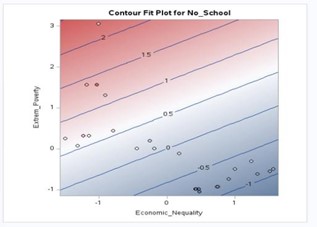Path Analysis Effect Corruption, Tax, Inequality Economy and Poverty Level Against Percentage of Teenagers Not Attending School
Main Article Content
Abstract
This research uses path analysis to examine the relationship between variables: Adolescents who are not in school (NS), corruption (CR), taxes (TR), economic inequality (EN), and poverty (EP). The aim of this research is to determine whether there is a direct effect of CR on TR, a direct effect of TR on EN, a direct effect of TR and EN on EP, and a direct effect of ENand EP onNS. The analysis results show that there is no direct effect of CR on TR but it is still meaningfulness with a value of 0.2588. The direct effect of CR on TR is-0.6984. There is a direct effect of TR and EN on EP. The effect of TR on EP is 0.1681. The effect of EN on EP is-0.5735. There is a direct effect of EN and EP on NS. The effect of EN on NS is 0.3859. The effect of EP on NS is 0.6037.
Article Details
References
[1] E Mulyasa. Becoming a Professional Teacher: Creating Creative and Enjoyable Learning. 2007.
[2] Siti Fadia Nurul Fitri. Problematika kualitas pendidikan di Indonesia. Jurnal Pendidikan Tambusai, 5(1):1617–1620, 2021 (in Indonesia).
[3] Ni Luh Kardini, Aria Elshifa, Susi Adiawaty, and Tri Cicik Wijayanti. The role of quality human resources in developing missions of future universities in Indonesian higher education. Munaddhomah: Jurnal Manajemen Pendidikan Islam, 4(1):49–59, 2023.
[4] E. L. Napitupulu. Primary and secondary education: Millions of children do not go to school, June 2022. Accessed: 2025-06-09.
[5] Timothy Besley and Torsten Persson. Why do developing countries tax so little? Journal of Economic Perspectives, 28(4):99–120, 2014.
[6] Elazar J Pedhazur. Multiple Regression in Behavioral Research: Explanation and Prediction. Thomson Learning, 1997.
[7] Peter Gilmour. Path analysis: Its use in transportation research. Transportation Research, 12(6):377–384, 1978.
[8] Imam Ghozali. Multivariate Analysis Application with SPSS Program. Semarang: Diponegoro University Publishing Agency, 2011.
[9] Thomas H. Wonnacott. Regression; A Second Course in Statistics. New York: Wiley, 1981.
[10] Herman J. Loether and Donald G. McTavish. Descriptive and Inferential Statistics: An Introduction. Boston: Allyn and Bacon, Inc., 1980.
[11] Jonathan Sarwono. Path analysis: Data analysis application. Jurnal Ilmiah Manajemen Bisnis, 11(2):285–296, 2022.
[12] Chaitanya G, Prabhuling Tevari, and Hanumanthappa D. Path analysis: An overview and its application in social sciences. International Journal of Agriculture Extension and Social Development, 7(4):299–303, 2024.
[13] Y. Osada, T. Yoshida, K. Yoshida, T. Kawaguchi, and Y. Hoshiyama. Path analysis of community response to road traffic noise. Journal of Sound and Vibration, 205(4):493–498, Aug 1997.
[14] B. R. Naveen and Anjula Gurtoo. Using path analysis to build a sustainable transport service quality model. In Contemporary Issues in Sustainable Development, pages 383–407. Routledge India, 2020.
[15] L. Pleshko and S. Baqer. A path analysis study of the relationships among consumer satisfaction, consumer loyalty, and market share in retail services. Academy of Marketing Studies Journal, 12(2):111–128, 2008.
[16] Adya Hermawati and Abhimanyu Tuwuh Sembhodo. Marketing strategy with path analysis in increasing competitive advantage in tourism industry SMEs in East Java. Journal of Theoretical and Applied Information Technology, 100(20):5931–5940, 2022.
[17] R. Bagozzi. Causal Models in Marketing. John Wiley and Sons, New York, 1980.
[18] S. M. Scheiner, R. J. Mitchell, and H. S. Callahan. Using path analysis to measure natural selection. Journal of Evolutionary Biology, 13(3):423–433, 2000.
[19] R. G. Latta and C. McCain. Path analysis of natural selection via survival and fecundity across contrasting environments in Avena barbata. Journal of Evolutionary Biology, 22:2458–2469, 2009.
[20] Zainuddin Iba and Aditya Wardhana. Pengolahan data dengan analisis jalur (path analysis). In Metode Penelitian. Eureka Media Aksara, 2024.
[21] D. R. Heise. Problems in path analysis and causal inference. Sociological Methodology, 1:38–73, 1969.
[22] S. A. Arsandi. The grease of the wheel in Indonesia: The effect of corruption. Journal of Anti-Corruption, 8:193–204, 2022.
[23] N. M. Yuliani, R. I. Paturochman, T. A. Mubarok, and R. A. Muzaki. Fiscal policy in addressing income inequality in Indonesia. Journal of Bina Bangsa Ekonomika, 18:296–300, 2024.
[24] H. Aisyah, M. D. Dahlan, and M. Aprila. The relationship between income inequality, poverty reduction and economic growth: A perspective from Indonesia. Jurnal Economina, 2:3722–3736, 2023.
[25] V. N. Alifa. Analysis of factors causing the increasing school dropout rate in Indonesia in 2022. Sultan Agung Education Journal, 3:175–182, 2023.
[26] S. Sri and Yeniwati. Causality analysis of poverty, child labor and school dropout rates in Indonesia. Journal of Economic and Development Studies, 2:15–24, 2020.

